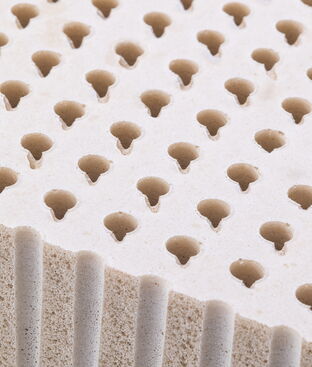Blog, Latex Mattresses
Why are Latex Mattresses so Heavy?
Latex mattresses are known for their comfort, durability, and support. But along with these benefits comes a notable characteristic: their weight. If you’ve ever tried to move a latex mattress, you know it’s no easy feat. In this article, we’ll delve into the reasons behind the substantial weight of latex mattresses, the implications of their heft on mattress support and firmness, and what this means for consumers.
Heavy Materials Latex Mattresses Made With
Latex mattresses are made with heavy Dunlop and Talalay latex. The Dunlop process results in a denser foam, while the Talalay process creates a lighter, more uniform texture.
Benefits of Heavy Latex Mattresses
Latex mattresses offer a variety of benefits that make them a popular choice. They are known for their ability to provide a balance of comfort and support, conforming to the body without the sinking feeling associated with some other types of mattresses. Additionally, latex is naturally resistant to dust mites, mold, and mildew, making it an excellent option for those with allergies. It’s also a breathable material, which helps to regulate temperature throughout the night.
The Weight of Latex Mattresses
Now, let’s explore the factors that contribute to the significant weight of latex and why this might be advantageous or disadvantageous to mattress owners.
1. Density and Material Composition
The primary reason for the weightiness of latex is the density of the material. Latex is inherently dense, which means it has a high weight per unit of volume. The more natural latex used in a mattress, the heavier it will be. This density is also what provides the mattress with its firmness and longevity but can make handling and moving the mattress challenging.
Dunlop latex weighs more than Talalay Latex. So, choosing a Talalay latex will lighten the load.
2. Size and Thickness
Another contributing factor is the size and thickness of the mattress. Naturally, larger mattresses, such as king and queen sizes, will be heavier due to the increased amount of material. Additionally, latex beds tend to be thicker than other types, often ranging from 6 to 13 inches, to provide optimal support and comfort. The thicker the mattress, the more material it contains, and consequently, the heavier it is.
3. Additional Layers and Materials
Latex mattresses often come with extra layers for added comfort and support, such as wool and cotton covers or a latex topper, which can add to the weight. Some models also incorporate other types of foam or innerspring systems to enhance the overall sleep experience, further contributing to the mattress’s heft.
Implications of Weight on Mattress Support and Firmness
The weight of latex is directly linked to their support and firmness. Let’s break down how this weight impacts the performance of the mattress.
1. Enhanced Support
The density that makes latex is heavy also makes them incredibly supportive. A heavier mattress can better resist the wear and tear of nightly use, maintaining its shape and support over time. This is particularly beneficial for individuals who need extra support, such as those with back pain or a higher body weight.
2. Consistent Firmness
Latex mattresses are known for their consistent firmness levels across the entire surface. The weight and density of the material prevent the formation of dips and sagging, which can occur in lighter, less dense mattresses. This means that sleepers can enjoy a uniform sleeping surface for many years.
Handling and Moving Latex Mattresses
Despite their benefits, the weight of latex can pose some challenges, especially when it comes to moving or rotating them.
Tips for Handling Heavy Mattresses
If you need to move a latex mattress, it’s essential to plan ahead. Consider the following tips:
- Use proper lifting techniques to avoid injury. Bend at the knees and lift with your legs, not your back.
- Enlist the help of others. A latex mattress is not a one-person job.
- Use mattress straps or a dolly to facilitate the move.
- Protect the mattress with a cover to prevent any damage during the move.
Considerations for Bed Frames and Foundations
The heavy nature of latex also means that they require a sturdy bed frame or latex mattress foundation. Slatted bases should have slats close enough to support the weight without bowing. Platform beds are an excellent option as they provide a solid surface that can accommodate the heft of a latex mattress.
Choosing the Best Latex Mattress
When selecting a latex mattress, it’s important to consider the weight alongside other factors such as sleeping position, firmness preference, and budget.
Factors to Consider
- Sleeping Position: Depending on whether you sleep on your side, back, or stomach, you may require different levels of firmness and support.
- Firmness Preference: Latex mattresses come in various firmness levels. Heavier individuals or those who prefer a firmer mattress may opt for a denser, heavier latex mattress.
- Budget: Natural latex beds tend to be more expensive than synthetic ones, but they also offer a higher quality of sleep and durability.
Conclusion
Latex mattresses are heavy due to their density and the quality of materials used. While this can make them cumbersome to move, it also contributes to the superior support, firmness, and durability that latex is known for. By understanding the reasons behind their weight and the implications it has on mattress performance, consumers can make informed decisions when purchasing a new mattress, ensuring they enjoy a good night’s sleep for years to come.
